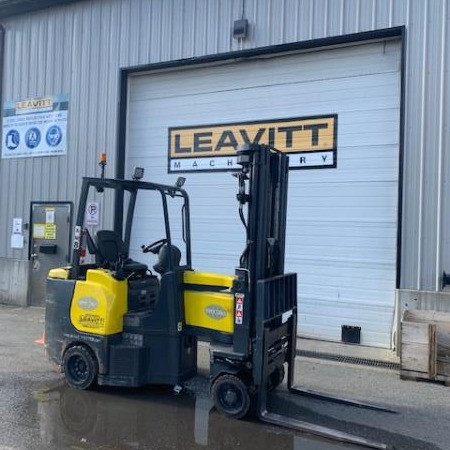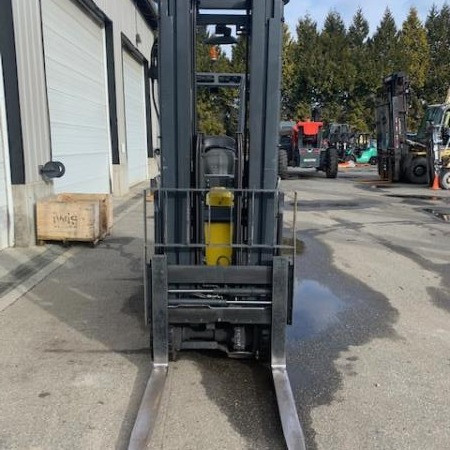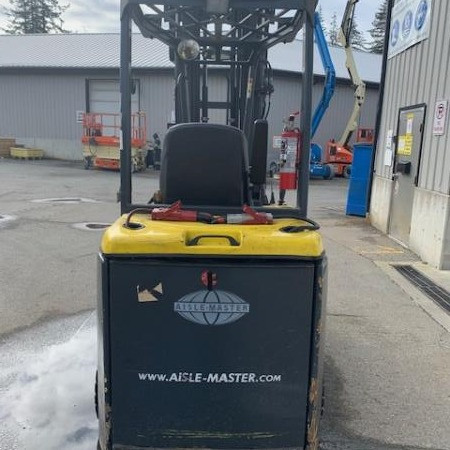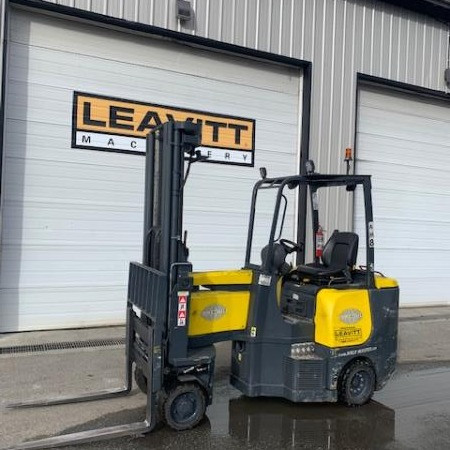Very Narrow Aisle Forklift Sacramento
Used Very Narrow Aisle Forklift Sacramento - Warehousing needs greatly focus on space-saving techniques and layout to maximize expensive square footage and decrease travel time needed to get goods from the loading docks and from point A to point B. Very narrow aisle solutions allow for more space to be dedicated to the storage of goods because less space is required for aisle access. Configuring the warehouse is known as warehouse optimization.
Warehouse Optimization
There are several significant benefits of implementing very narrow aisle warehouse optimization.
Since very narrow forklift trucks have been designed to take up significantly less space, warehouse aisle widths can be reduced to half the width needed by traditional forklifts. Numerous narrow aisle forklifts deliver better stacking heights to increase the storage capacity on a square foot basis. Very narrow aisle forklifts can greatly reduce costs compared to traditional forklifts since the same amount of stock takes up less space in the warehouse. Most urban locations have expensive square footage; therefore, reducing costs is a benefit to warehouses and their business. Warehouse storage can be increased up to eighty percent with careful planning when a narrow aisle width configuration is utilized. Very narrow aisle design facilitates greater product access and more rack faces. Since greater quantities of products are situated in a more accessible area, there is less travel time needed for gathering and storing items.
It is common for warehouses to use a very narrow or narrow aisle layout. Less than eleven feet of aisle width is needed by narrow aisles. These widths reduce even further to roughly 6.5 feet for very narrow aisles. Either of these widths drastically increases storage potential. However, they also create challenges when turning within the aisles using forklifts for stocking and order picking. A variety of very narrow forklifts have been designed to easily maneuver in narrow aisles.
It is necessary to know the dimensions of the aisle when selecting a forklift for a certain job. Taking note of the proper dimensions will save valuable time and money by avoiding the mistake of acquiring a forklift that will not work in the intended application. Taking note of any utilities, columns or posts is necessary before choosing a particular narrow aisle forklift design to maximize warehouse optimization and safety.
Very Narrow Aisle Forklift Trucks
Very narrow aisle forklift trucks are almost always powered electrically, usually by rechargeable battery. Stand-up riders are a popular design for very narrow aisle forklift trucks. The most commonly used types of very narrow aisle forklift trucks are:
1. Reach trucks
2. Order pickers;
3. End-control riders; and
4. Turret or swing-mast.
Reach Forklift Trucks
Reach trucks were designed as a version of the rider stacker forklift but specially modified for use in narrow aisles. This machine earned its name by its ability to reach its forks to secure a load. The moving mast and the moving carriage are two types of reach trucks. The moving carriage works by raising and lowering the carriage, along with the operator. While the operator stays at ground level, the moving mast is responsible for raising and lowering the forks. The moving reach truck is typically considered the safest out of the two kinds of reach trucks. Reach trucks use a pantograph system, a type of jointed framework, which allows the operator to reach for or place a load without the need to move the forklift itself.
Order Pickers
Order pickers have been created to pick items from difficult, high racking systems. These machines are used for picking up lighter stock that can be moved by hand. These order pickers work by lifting the operator up to the level of goods in order to identify and pick the specific item or items necessary to fill an order.
End-Control Riders
End-control riders are used to pick loads located at floor level and transport the load horizontally, rather than lift or lower loads from various heights.
Turret or Swing-Mast Forklift
Swing-mast or turret very narrow aisle forklifts feature an articulating swivel mast that pivots. The mast swivels allowing pallets to be placed on either the left or right of the forklift.
Guided Very Narrow Aisle Trucks
Rail or wire can guide the very narrow aisle forklift trucks down the aisle securely.
Since the forklift truck is guided, the chance of colliding with racks while traversing down the aisles is very low. Rail-guided applications use special rails set into the floor on either side of the aisle, funning the length of the location and curving around the edge. Wheel guides on the forklift slide into the floor rails to stop the machine from traveling out of bounds.
Running down the center of the aisle, wire-guidance forklifts rely on floor wires instead of rails. The wire-guides function similarly to the rail systems except the forklift has a wire-guide system to prevent the machine from traveling where it is not supposed to.
Work Site Considerations
To use a narrow aisle configuration, there are some key considerations that need to be made. Because these very narrow aisle configurations include very tall racking systems, the condition of the floor and the construction of the racks must be done properly in order to avoid potentially disastrous outcomes. There are four main locations that need to be ideally prepared before any racking system can be installed. These areas need to be monitored continuously including fixing cracks in the floor, ensuring the racks are straight, a level floor and an appropriate load capacity of the floor.
Level Floor
Because of the height of the racking systems, any slight slope of the floor is likely to negatively affect the plumbness of the racks, especially over time when loads are continuously placed and removed on the racks. A level floor is vital for the safety and integrity of the operator, employees, stock and the warehouse.
Crack Repair
When there are floor cracks found, they need to be assessed and immediately fixed for safety concerns. Safety can become compromised when flooring cracks become 3/8 inches wide. They require proper filling with a substance that is as hard as the floor.
Floor Load Capacity
Minimum flooring requirements must be met before considering a narrow aisle installation. The floor should have three thousand psi concrete minimum and contain evenly distributed rebar at three to four inches under the surface. Depending on the configuration and load requirements, extra reinforcements may be necessary.
Plumb Racks
The racking system is essential to the whole process and needs to be installed properly. If installed improperly, there is a great chance of rack failure. Every rack needs to be plumb to ensure a safe system and work environment. Rack shims can help the rack stay plumb to one inch at the height of thirty feet.
Racking failure can happen if the aforementioned measures are not taken or implemented correctly. Employees can become hurt or killed in the event that racking failure occurs. Goods can be damaged along with forklifts and other equipment. Due to these potential problems, the most significant part of creating a narrow aisle configuration for warehousing optimization is the initial measurements.
Very Narrow Aisle Forklift PDF
Stock Number: 209213 GL
Make: AISLEMASTER
Model: 44SE
Year: 2015
| Stock Number |
209213 GL |
| Make |
AISLEMASTER |
| Model |
44SE |
| Year |
2015 |
| Category |
Very Narrow Aisle Forklift |
Stock Number: 208758 GL
Make: AISLEMASTER
Model: 44SE
Year: 2015
| Stock Number |
208758 GL |
| Make |
AISLEMASTER |
| Model |
44SE |
| Year |
2015 |
| Category |
Very Narrow Aisle Forklift |
Stock Number: 207213 GL
Make: AISLEMASTER
Model: 44E
Year: 2013
| Stock Number |
207213 GL |
| Make |
AISLEMASTER |
| Model |
44E |
| Year |
2013 |
| Category |
Very Narrow Aisle Forklift |













